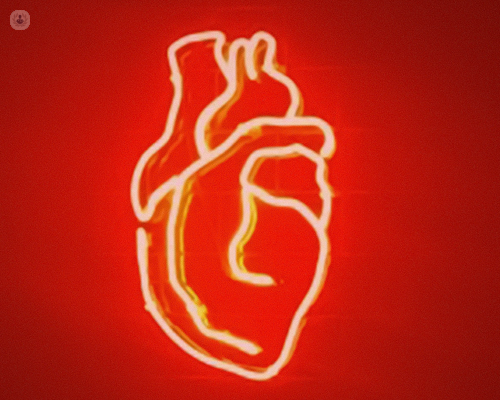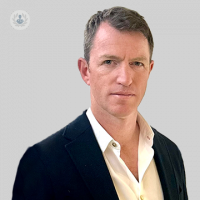Catheter ablation: Finding your rhythm
Written in association with:Abnormal heart rhythms are caused when the electrical signals that regulate the heartbeat don’t function correctly. Catheter ablation is a procedure used to help correct these irregularities. Esteemed London-based cardiologist, Dr Malcolm Finlay explains the procedure in detail, outlining what the patient can expect, some risks to be aware of, and much more.

What is catheter ablation?
Catheter ablation is a treatment option for heart rhythm problems. The procedure is either under local or general anaesthetic. Thin wires and catheters are inserted through the leg, running along the veins of the body to the heart, and monitor the electrical signals, indicating the abnormal areas of the atrial tissue to be treated with ablation. During the ablation, energy will be passed through the tips of the catheters to treat abnormal tissue. The procedure lasts approximately an hour in most cases. The patient returns to the ward, and within two to three hours, they feel back to normal, but can feel exhausted for up to a week. Normally, patients go home the same day or the following morning.
Who qualifies for catheter ablation? When is it needed?
Catheter ablation is a safe, quick, and effective treatment that is suitable for most patients with heart rhythm problems. Over the years, the treatment has improved and thanks to its high success rate, has been used more frequently to treat patients. Patients with atrial fibrillation, particularly paroxysmal atrial fibrillation, that comes and goes, really respond very well to ablation treatment. Similarly, patients with SVT or atrial flutter are very good candidates. Patients with these conditions should really consider ablation as a useful treatment option.
How is catheter ablation done?
Catheter ablation is performed in a specialist lab. With ultrasound guidance, two or three small tubes are inserted into the top of the leg, through which the catheters are inserted into the veins. Depending on the type of ablation being carried out, a combination of x-ray and some complex 3D mapping technologies may be used to locate the catheters in the heart. For AF ablation, for example, typically just x-rays are used as there are defined anatomical sites that ablation is performed on. In other types, such as atrial tachycardia ablation, the exact location of the abnormal tissue needs to be mapped out, requiring some complex 3D computer systems. Following the procedure, the tubes are removed from the leg and a tiny stitch placed to stop any bleeding. Usually, this can be removed within an hour or two before the patient goes home.
What can patients expect from catheter ablation?
Patients can expect a straightforward and safe procedure, with minimum pain and discomfort experienced during and after the procedure. The vast majority of patients experience either significant or complete elimination of their symptoms. However, there are some cases there is a risk of causing damage, but this will be discussed with the patient prior to the procedure, as their safety is the top priority.
What are the risks of catheter ablation?
Like any medical procedure, there are risks involved when performing catheter ablation, determined by the type of ablation being performed. An SVT ablation procedure, which includes an atrial flutter ablation, has very few risks associated with it. There’s a chance of bleeding or bruising at the top of the leg, Likewise, there is a tiny risk of bleeding around the heart due to the insertion of the catheter, which can be treated with a simple drain. More serious complications are thankfully rare. The normal conduction system, which runs quite close to some of the areas treated by ablation, may be damaged and as a result, the patient may require a pacemaker. Fortunately, this only occurs in about 1 in 200 cases.
AF ablation is safe when compared to most elective procedures, about 97% of people who undergo it do not experience complications. Nevertheless, in some cases, patients may experience problems as a result. The main one is bleeding around the heart caused by the inserted tubes scratching the surface of the heart during the procedure. This is straightforward to treat, usually with a tube that goes under the diaphragm to drain the blood collecting around the heart, but in extreme cases, a tiny hole causing the bleeding may need to be sewed up involving further surgery.
Although there is a risk of severe heart damage, such as heart attacks, strokes, or damage to the lungs or breathing muscles, or the swallowing tube, it is very rare. In extremely rare cases patients have very sadly died as a result of complications after procedures.
How long does an ablation last? Does it last forever?
Most SVT or atrial flutter ablations will last forever and the majority of patients who undergo an AF ablation will also find that lasts forever. There's that tiny risk of a little bit of atrial fibrillation coming back following AF ablation, some patients may need a second procedure to get a long-term result.
How long does it take to recover from catheter ablation?
Patients treated with catheter ablation are normally able to move around within a few hours. They will have some soreness at the top of the leg, perhaps in the chest as the heart heals, and they may experience flutters in their heart in the weeks following the procedure. Nevertheless, that doesn’t mean that the procedure hasn’t been successful. Most feel back to normal within just a few days but it is advisable for patients to take it easy for a week after catheter ablation.
If you are interested in booking a consultation with Dr Malcolm Finlay, you can do so directly by visiting his Top Doctors profile.


